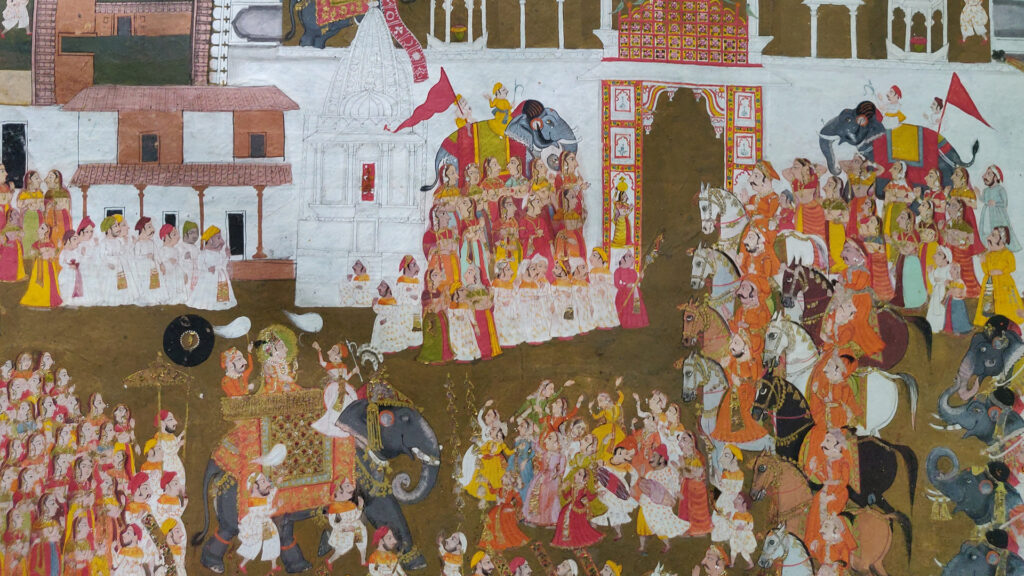This art laboratory at the City Palace Museum, Udaipur, is abuzz with a host of ethical conservation efforts. We get an exclusive look.
By BINDU GOPAL RAO
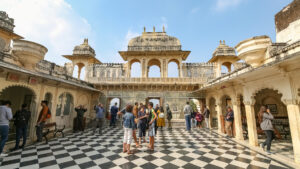
Udaipur’s City Palace museum is a huge draw for tourists and needs no introduction. It is the repository of a priceless art collection that has been handed down over generations, attracting local and international art and heritage enthusiasts. However, beyond the ‘No Entry’ boards, there is a treasure trove kept out of bounds for tourists.
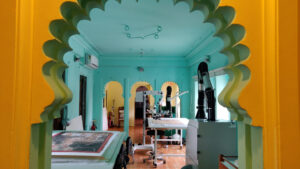
Located within the palace complex is the Conservation Laboratory, where specialists work on art restoration projects. A small group of dedicated conservation experts sit near the entrance of the lab, working painstakingly on what appears to be a set of large paintings. While the plans for the Conservation Laboratory at the City Palace Museum, Udaipur, were conceptualised in 2015-2016, the structural restoration of the selected space commenced in 2017, and the laboratory became fully functional in January 2018. It has been set up not just to cater to the collections of the museum, but also to serve as a centre of expertise and knowledge-sharing with national and international institutions. The dedicated team comprises consultant conservator S Girikumar, and two full-time conservators, Anuja Mukherjee and Bhasha Shah.
THE PROCESS
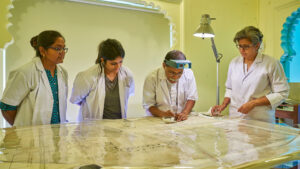
The conservators at the lab are currently working on Mewar paintings, and they have already restored about 35 art pieces to date. Each painting goes through a unique set of conservation processes.
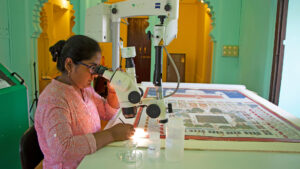
Mukherjee explains, “When an artwork comes to the lab for conservation, the required treatment depends on its material composition and condition. First, the painting is unframed. Then, it is examined closely through a microscope, by clicking photographs in natural and raking lights, which show the painting’s texture and detailing accurately. Detailed documentation of the nature and condition of the artwork, and a tentative course of treatment are established. If the paper on which the artwork is done is thin, transmitted images are used. Here, a backlight helps detect the thickness of the ink and identify the pigments used in the paint.” All the paintings that are currently being restored belong to the City Palace Museum, Udaipur, an integral part of the Maharana of Mewar Charitable Foundation, Udaipur. Treatment often starts with a spot test (to avoid colour bleeding), followed by cleaning the object with solvents and a soft brush.
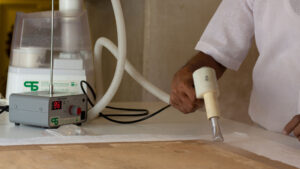
As the weather in Udaipur is very dry, these paintings are mostly found with their top layer cracking and flaking. In that case, the consolidation of the flaking paint layer is carefully performed using a suitable adhesive.
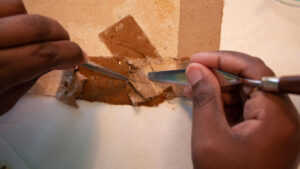
Removal of old tape from the back of the paintings is also a part of the restoration process. “Another kind of damage is delamination, in which layers of paper support—which are fixed using adhesives—get separated as they lose adhesive strength. Tears and losses are infilled using Japanese tissues, whose fibrous nature merges with the original handmade paper to provide overall structural stability to the paintings,” explains Shah.
AN INSIDE LOOK
The lab itself has several sections and is laid out in a vertical design, with all the equipment and working tables kept movable to ensure optimum use of space. There is a separate section for mounting the artwork, and a couple of areas are occupied by the conservators. Towards the extreme end is the area where water-based treatments are done. Since transporting paintings to the lab is challenging, due to the narrow alleyways within the palace, a provision has been made for a 16-foot hydraulic lift to safely transfer these paintings from the courtyard to the laboratory with minimal vibrations. The lab has a forward-thinking ethos —the equipment here has been chosen to help the ongoing and future conservation requirements. The studio lights help in photographic documentation of the artworks. In order to keep the dust away, windows have been sealed. Fume extractors ensure that all hazardous fumes from the chemicals used in the treatment are removed.
INTEGRITY INTACT
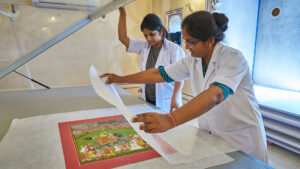
A key aspect of the paintings is, of course, the paint used. Over time, several paintings have witnessed a loss of medium, so much so that the underdrawings have become visible. Girikumar explains, “Reintegrating or in-painting the lost areas is done ethically, without interfering with the original intention of the artist. Usually, we never paint anything unless there is a hole or loss that has been reconstructed. That’s when we in-paint a neutral colour so that it merges with the original work.” Once the paintings are ready, they will be stored in a special storage area and mounted using archival quality mount boards. All the paintings will be stored in flat file drawers, interleaved with archival quality tissues to ensure that they are preserved well. The conservation of art using ethical means, is indeed a task, but is also the best way to make sure the next generation looks back at Indian art and heritage with pride.

“This whole business of restoration of paintings is very new in India. Our climatic conditions cause paintings to deteriorate. When they are not displayed in ideal, controlled environments, moisture, heat and temperature variations wreak havoc on them. While it is expensive to maintain them in such conditions, there is a clear realisation that these paintings need to be conserved. I am getting a lot of requests from other people who want to do this, as we have a world-class team that is working on the restoration process. In that sense, we have always been ahead of our time. Now, many other museums are following suit. However, this is a laborious, time-consuming and expensive process, and it will take a long time before it makes an impression on the minds of people. Artworks don’t deserve to die, and we are striving hard to conserve them all.”
Related: Explore The Reason Behind India’s Successful Art Market

